 E aí, pessoal? E aí, pessoal?
Quando me propus a escrever sobre os maiores nomes da história do kart nacional, ou os “Marvados”, como carinhosamente os tenho chamado aqui, obviamente pensava nos nossos campeões mundiais de kart, o Guga Ribas, o Gastão Fraguas e o Rubinho Carrapatoso. Pretendia fazer uma matéria com os três, e para isso lhes enviei um questionário, pois assim poderia detalhar melhor algumas passagens de suas carreiras que até hoje são desconhecidas do grande público. Acontece que a entrevista do Guga ficou simplesmente sensacional! Por isso, reproduzo abaixo na íntegra o texto dele, para o deleite de todos nós. Com vocês, o “Marvadão” Guga Ribas: NdG – Espaço Karting: Como você começou no kart? Guga Ribas: Desde muito pequeno sempre fui apaixonado por carros, velocidade, e desafios. Mas não fosse um advogado, e grande amigo da família, chamado Jose Perez de Rezendeter convidado meus irmãos e meu pai para irem assistir uma corrida de kart no extinto e saudoso kartódromo Maqui-Mundi, diga-se de passagem, uma fantástica pista, acho que jamais teria conhecido o esporte que me faz estar escrevendo esse artigo. Nessa época eu tinha 13 anos e perguntei ao meu pai se eu poderia ir junto. Nossa, ainda me lembro como se tivesse sido ontem, de estarmos chegando no kartódromo e ouvir o ronco dos motores passando pela reta, do cheiro da queima da mistura da gasolina com o óleo M50, da velocidade com que aqueles “carrinhos” passavam na minha frente, e de como aquela imagem mexeu comigo! Fiquei absolutamente fascinado. Mal sabia que naquele primeiríssimo contato com os karts e com aquele ambiente começava minha carreira. 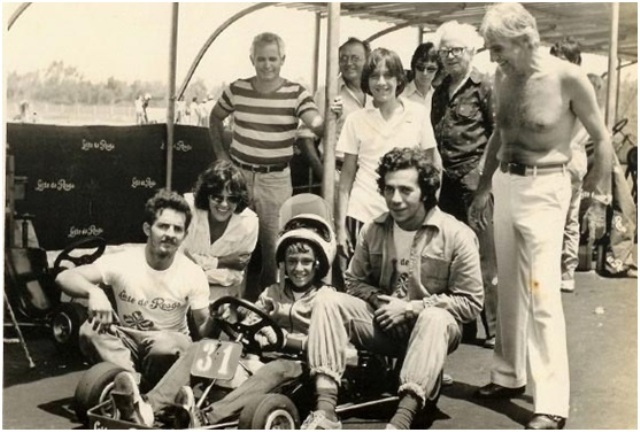
Em 1977, no kartódromo Maqui Mundi, Guga Ribas acelerou pela primeira vez um kart. Ainda na volta para casa pedi ao meu pai que me desse um kart e que me deixasse correr, no que fui atendido muito rapidamente. Além de meu pai sempre nos apoiar em tudo que queríamos fazer, ele também era um apaixonado pela velocidade, e isso fez com que a família toda acabasse por se envolver com o kartismo durante quase 20 anos. No meio daquele ano foi criada a equipe Leite de Rosas, composta originalmente por 5 pilotos: Jose Rezende, o único com alguma experiência, meu irmão Mauro Ribas, meu primo Osvaldo Modesto Leal, o marido da minha madrinha e grande amigo da família Hamilton Borges Fortes e eu. 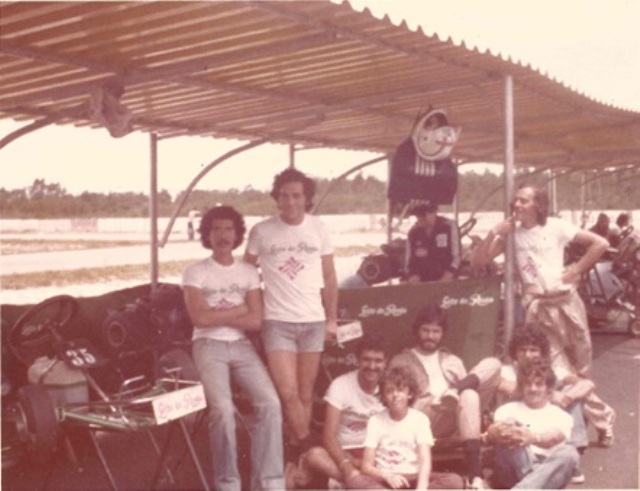
Uma foto com parte da equipe no Rio de Janeiro, em 1977, ano do início de uma trajetória vencedora... campeã! Meu pai, muito sabiamente, disse que eu treinaria junto com os demais da equipe, mas só faria minha estreia na última etapa daquela temporada. Concordei e no dia 27 de Novembro de 1977 fiz minha corrida de estreia, conquistando minha primeira vitória. NdG – Espaço Karting: Como você descreveria o seu estilo de pilotagem no kart? Guga Ribas: Impossível falar do meu estilo sem falar como ele foi criado. Como sempre digo, não tenho ídolos, até porque para mim ídolos deveriam ser perfeitos, nunca cometeriam erros e todos sabemos que isso não é possível. Por outro lado tenho alguns pilotos, atletas, e mesmo pessoas “comuns” como exemplos. Alguns a serem seguidos, outros não, mas todos eles fizeram e fazem parte da minha vida até hoje. 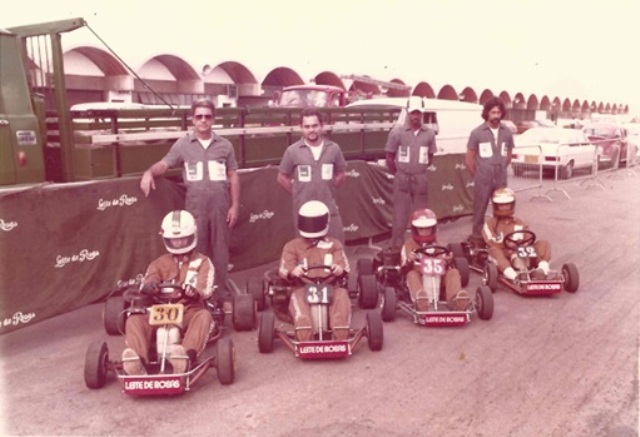 Equipe durante o Campeonato Carioca de 1979 realizado no autódromo do Rio de Janeiro devido ao fechamento do kartódromo Maqui Mundi, que foi reaberto no ano seguinte pelo Sr, Ribas, pai de Guga Ribas. Por Ordem da esquerda para a direita: José Perez Rezende, Hamilton Borges Forte, Guga e Mauro Ribas e seus respectivos mecânicos. Como sou um dos mais velhos da minha geração, e comecei cedo para a época, acabei fazendo parte de uma entre-geração que teve como exemplos pilotos como Ayrton Senna, Mario Sergio Carvalho, Dionísio Pastore, Eduardo Vargas, Mario Batalha Seixas (Marrom), Mike Wilson, Alessandro Zanardi, Gianni Morbidelli, com quem tive o privilégio e o prazer de competir. Além disso, a geração anterior a essa, tinha pilotos como Walter Travaglini, Toninho da Matta, Terry Fullerton entre outros monstros sagrados do nosso esporte. Tive muita sorte de poder vê-los guiando. Ao longo do tempo acabei tirando um pouco de cada um deles e criei meu próprio estilo. Cada vez que os via andar, cada vez que corria com eles, cada dia no box durante as corridas aprendia muito, assimilava muita informação e posteriormente estudava isso tudo inconscientemente, e me modificava, me adaptava. Acabou sendo um processo de amadurecimento. Devo muito a cada um deles e a algumas outras pessoas que comentarei oportunamente. 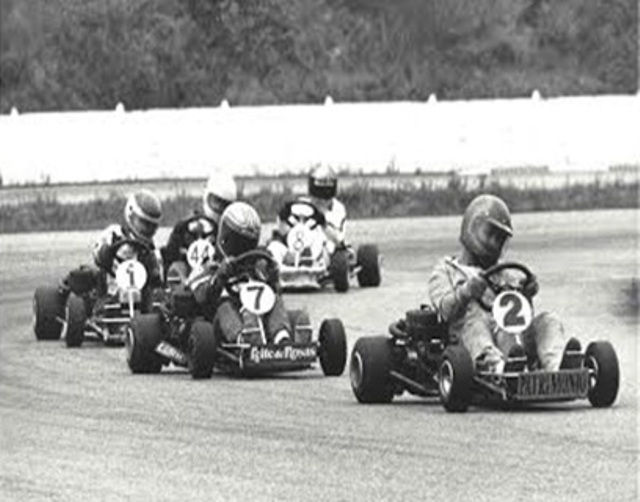
Etapa do Camp. Carioca de 1982 Por ordem: Mario Batalha Seixas (Marrom), Guga, Sergio Caula, Edu Vargas e Renato Zanni. Por fim, meu estilo acabou sendo muito agressivo na pista e muito técnico no box. NdG – Espaço Karting: Fale sobre o Mundial de 86... Existe alguma história interessante sobre este campeonato que seja inédita? Guga Ribas: Era meu segundo mundial e dessa vez numa equipe semioficial só para mim. Não tinha companheiro de equipe e por isso tinha 100% de atenção do meu mecânico que era absurdamente experiente com aquele equipamento. Eu também estava muito mais bem preparado do que no Mundial de Parma no ano anterior. Sabia do que era capaz, mas estava ciente das dificuldades para vencer um mundial. Só quem já participou de um mundial, entende o que estou dizendo. 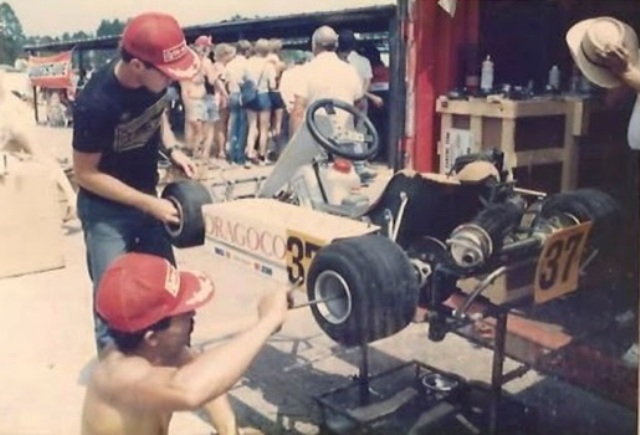
Numa estrutura semi-oficial, e com um mecânico cuidando exclusivamente do seu kart, Guga Ribas viu isso como vantagem. Existe uma mística sobre o meu título. Algumas pessoas dizem que só venci esse mundial porque os europeus desistiram de correr. É obvio que não posso garantir que venceria se os europeus tivessem participado da corrida, mas é fato que eu era um dos mais rápidos desde os primeiros treinos, sendo que todos treinaram a semana toda, só tomando a decisão de não participar da corrida na véspera da classificação, após uma reunião pedida pelo Mike Wilson com os pilotos europeus. Importante ressaltar que durante toda a semana, todos treinávamos normalmente e sempre estive entre os 3 primeiros. Aliás, os mais rápidos eram sempre Gianni Morbidelli, Yvan Muller e eu. E antes de tomar a decisão de correr, na noite antes da classificação, tive uma conversa com alguns pilotos europeus e também com o Sr. Bruno Grana, dono da minha equipe (IAME) e todos me incentivaram a correr. A decisão do boicote europeu, em minha opinião foi muito mais política do que técnica. De fato, era uma pista perigosa, mas todos sabíamos disso desde a primeira volta do treino. Então por que esperar até o ultimo dia de treino para desistir? Claro que a desistência deles simplificou as coisas, mas em momento algum foi fácil, e muito menos os europeus menosprezaram minha vitória. Muito pelo contrário. 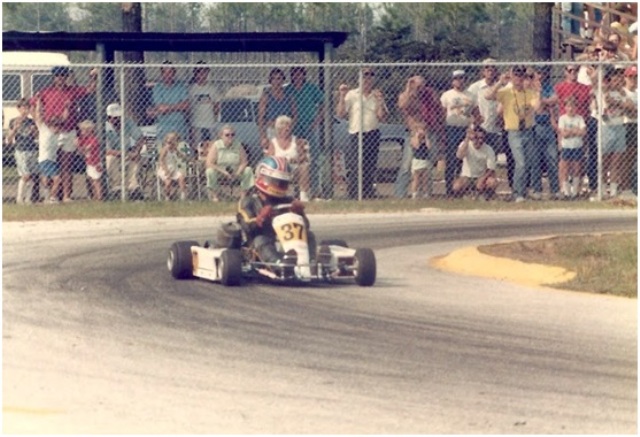
Independente do boicote por parte dos pilotos europeus, Guga Ribas estava entre os mais rápidos na pista e venceu. Os principais pilotos como Yvan Muller, Jorn Haas, Lars Forsman e a grande maioria dos pilotos europeus vieram me parabenizar. Recebi convite de equipes americanas para competir nos EUA. O simpaticíssimo Sr. Lorenz Aebi, dono da fábrica e criador dos famosos carburadores IBEA, durante a festa de comemoração realizada pela Iame para mim, veio me presentear com dois de seus carburadores e conversar comigo para eu ir para Europa correr. Alguns meses mais tarde, Sr. Bruno Grana, dono da IAME, diga-se de passagem uma pessoa adorável, veio ao Brasil e me convidou para correr pela fábrica na Europa no ano seguinte, convite que não aceitei por entender que minha história no kartismo terminava ali. Como terminou. Queria seguir para os monopostos. NdG – Espaço Karting: Quais foram os seus principais adversários no kart? E quais foram os pilotos que mais te impressionaram? Guga Ribas: Tive muitos adversários excepcionais. No Brasil, a lista é grande: Eduardo Vargas, Mario Batalha Seixas (Marrom), Tullio Meneghini, Paulo Carcasci, Oswaldo Negri, Mario Sergio Carvalho, Bruno Aguiar, Ricardo Matos, entre outros. Nos mundiais dos quais participei, os pilotos que mais me chamaram a atenção foram: Mike Wilson, por ser o piloto que melhor vi aproveitar oportunidades durante uma corrida, e Gianni Morbidelli pela sua agressividade guiando. NdG – Espaço Karting: Li uma entrevista sua na época da conquista do mundial em que você dizia que não almejava as categorias maiores do automobilismo, mas simplesmente seguir com os negócios da família. Isso é verdade? Guga Ribas: Era muito jovem e cheio de sonhos. Não sabia muito bem o que queria fazer. Naquela época o mundo era “muito maior” do que é hoje. Os meios de comunicação eram extremamente precários, tudo era mais difícil, e como sempre fui um cara muito família, o fato de ter que ir morar sozinho e enfrentar desafios num país estranho era grande demais para mim naquele momento. Sempre precisei da minha família e amigos. Aliás, isso não mudou até hoje e jamais mudará. Minha família e amigos são as coisas mais importantes que tenho na vida. Não me arrependo da minha decisão de não ter ido embora. Minha carreira aqui no Brasil foi longa e poderia dizer que vitoriosa. Estou feliz tendo sido como foi. NdG – Espaço Karting: Como foi a sua parceria com o Rino Genovese? Guga Ribas: O que dizer do “Véio”??? Meu segundo pai! Um cara que me adotou como filho, amigo e parceiro. Meu padrinho de casamento. Era ele que me dava cigarros quando ambos fumávamos e meu pai não me deixava fumar ainda. Eu não era só um piloto para ele. Ele me ensinou muito mais do que sobre corridas, vitórias, derrotas, acertos, motores e carburação. Aliás, ele era o rei dos carburadores diferentes. Toda corrida, eu tinha que testar um sem número de carburadores que ele trazia sempre. Mas o que nos uniu mesmo é que tínhamos uma afinidade fora do comum. Ele me ajudou a ser o homem que sou hoje com nossas conversas noites adentro sobre família, negócios, caráter, enfim, sobre a vida. A única maneira de descrever minha relação com o Rino é dizer que éramos como pai e filho. Tínhamos nossas discussões... Aliás, muitas! Mas sempre com muito respeito e uma admiração mútua sem tamanho. 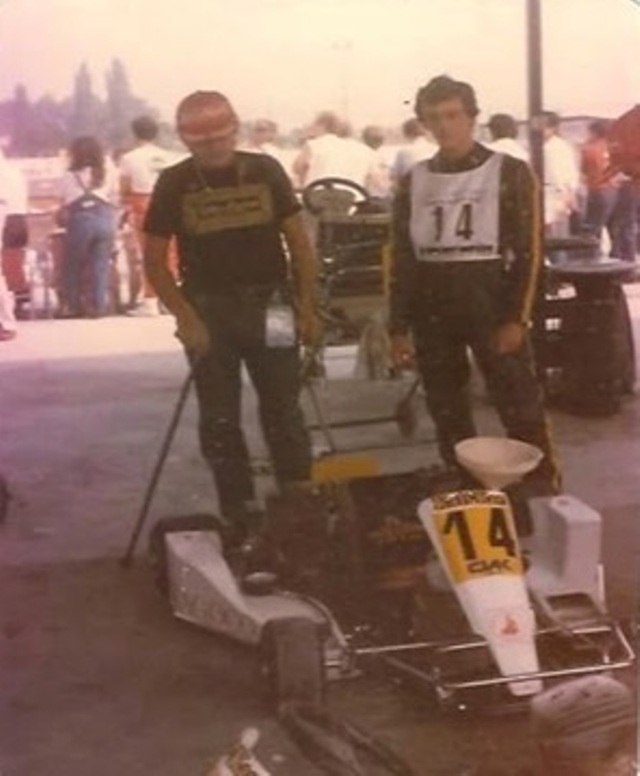
Em 1985, Rino Genovese acompanhou Guga Ribas no campeonato mundial de kart, em Parma, na Itália. Meu único arrependimento foi não tê-lo tido ao meu lado quando ganhei o Mundial. Não tive recursos para que ele fosse comigo. Sei que isso foi uma mágoa enorme para ele, mas ele foi incapaz de me dizer. Como um grande amigo e pai, se encheu de orgulho pela NOSSA vitória. Principalmente por ter sido uma conquista com um motor feito por ele, de um piloto que ele preparou para isso. Para se ter um exemplo da atenção dele comigo, no Mundial de 85 em Parma, na primeira bateria das eliminatórias, eu que sempre tive uma característica extremamente agressiva, principalmente nas largadas, perdi algumas posições. Depois da bateria ele veio a mim, me deu uma bronca e perguntou por que eu tinha largado tão mal. Não entendi e respondi: “mas eu passei o cara que estava largando na minha frente”. Ele então me pegou pelo braço e me fez ver a largada da outra eliminatória, e me disse: “preste atenção como eles largam aqui”. Só então percebi que nas voltas de apresentação, as únicas posições respeitadas eram as 3 ou 4 primeiras filas, daí para trás, quem chegasse primeiro era dono. Nas outras largadas, voltei a ganhar muitas posições, e ele me disse: “Ah, meu piloto voltou!”. Depois da perda dos meus pais, certamente foi a maior perda que tive na minha vida. NdG – Espaço Karting: Fale sobre a aventura de montar uma fábrica de chassis de kart nos anos 80 aqui no Brasil: as principais dificuldades, as conquistas... Guga Ribas: No início, foi bem conturbado esse processo. Na realidade esse projeto foi uma ideia do meu pai, que sempre foi um cara extremamente empreendedor. Contudo, naquele momento da minha carreira eu não queria ser um empresário e sim um piloto. Discuti muito com ele e disse que se ele quisesse fazer eu não participaria do projeto. E assim foram os primeiros 6 meses. 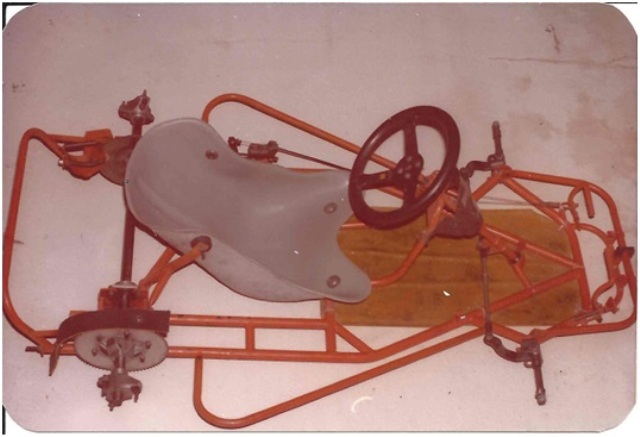
Uma parceria com o Nobre do Grid, Francisco Lameirão, foi capaz de gerar um novo kart, de chassi triangular. No começo 1983, meu pai comprou um projeto do Chiquinho Lameirão e começou o desenvolvimento com um dos funcionários e um amigo dele gerenciando. Eu continuei correndo com os chassis da Mini. No meio do ano, voltamos a conversar sobre o assunto e nos acertamos. Daí em diante, passei a gerenciar o projeto de desenvolvimento e começamos a fazer os testes de pista. Já em 1984 estreei o chassis CLR com um projeto inovador para o Brasil, que era um chassis triangular com freio mecânico. Nessa temporada, fiz todas as poles do ano, excetuando uma porque tive um problema na classificação, liderei todas as provas e venci apenas duas. Em todas as outras tive problemas mecânicos. O projeto então, ao longo desse ano, passou por uma série de aperfeiçoamentos e pude vencer quase todas as provas das quais participei. No Campeonato Brasileiro de Ipatinga, das cinco categorias, conquistamos 3 poles. O projeto já era muito bem sucedido, mas não tínhamos estrutura para enfrentar a Mini, que já era a maior fábrica da América Latina e jogava pesado para manter os concorrentes afastados. Sempre que conseguíamos um piloto bom para andar com nosso equipamento, ofereciam condições melhores para esses pilotos e nós não tínhamos como cobrir as ofertas. 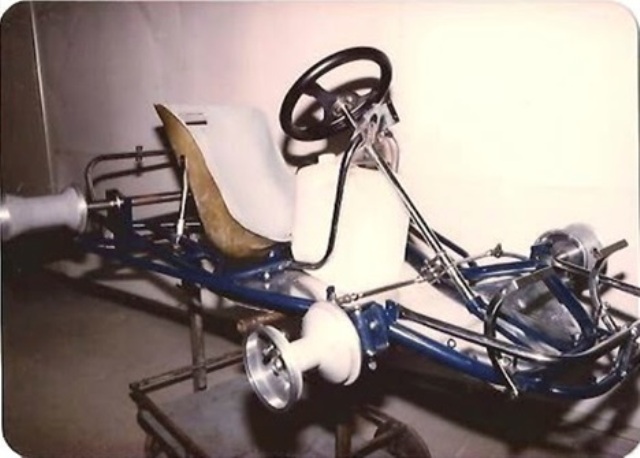
O projeto do chassi triangular feito por Francisco Lameirão foi o melhor chassi de kart no Brasil por alguns anos. Desta forma, quando parei de correr de kart em 1986, o projeto CLR de certa forma perdeu força e aos poucos acabamos saindo do mercado. Mas é muito gratificante ter participado, gerenciado e desenvolvido um projeto que acabou gerando o melhor chassis de kart do Brasil durante alguns anos. Orgulho-me disso. NdG – Espaço Karting: O que o fez partir para a carreira do tiro esportivo? Conte sobre este outro desafio e também fale sobre as suas conquistas nesta área. Guga Ribas: Em 1994 fiz minha última temporada no Campeonato Brasileiro de Marcas. Já estava cansado das frequentes viagens e da rotina das corridas. Além disso, eu já tinha meus dois primeiros filhos, e como já disse, sempre fui muito agressivo guiando. De repente, um dia em um treino aqui no Rio, me peguei pensando durante uma volta, no que aconteceria com meus filhos se eu sofresse um acidente mais grave. Eu sabia que, pelo meu estilo de guiar, minhas chances de sofrer um acidente eram maiores. Daí para frente, comecei a mudar meu estilo, sendo menos agressivo. Era uma espécie de autoflagelo: Resolvi parar. 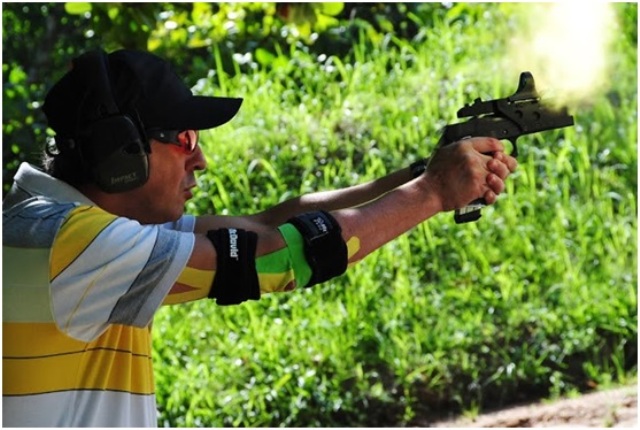
Nos anos 90 Guga Ribas deixou o automobilismo, mas não as competições. Ele passou a praticar o Tiro Prático. Fiquei parado um ano, mas no final de 1995, recebi um convite para correr na Stock Car. Conversei com minha esposa e parceira eterna e resolvi voltar. Seria uma experiência totalmente nova, pois seria a primeira vez que guiaria para uma equipe que não fosse de minha propriedade. Até então, eu havia sido sempre dono e chefe de minhas equipes. Não foi a melhor experiência que tive no automobilismo e no final de 1996 resolvi parar definitivamente. Mas o problema é que sou um apaixonado por competição. Vivo nelas desde os 13 anos de idade e acho que vou morrer competindo. Então o que poderia fazer daquele momento para frente? Pensei no Tiro Pratico que já era meu hobby e no qual já tinha participado de algumas competições regionais, nacionais e até internacionais, mas sem treinamento. 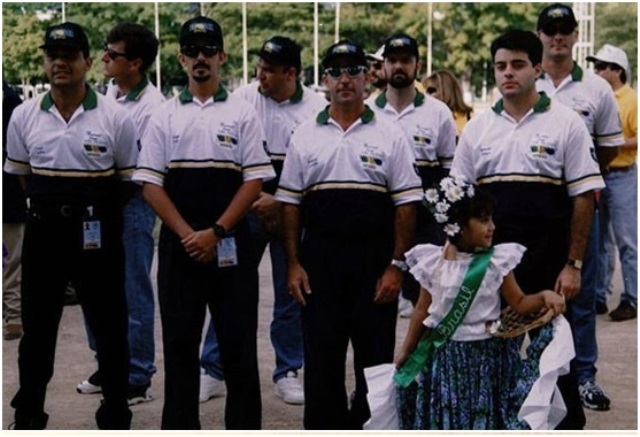
O ano é 1997. O Brasil e sua delegação para o campeonato latino americano. Guga Ribas é o 2º da dir p/ esq. Passei a treinar seriamente e coloquei como meta para ano de 1997 de me classificar para a equipe Brasileira que iria participar do Campeonato Latino Americano, na Venezuela, no final do ano. Para tanto eu deveria estar entre os 4 primeiros do ranking na época do campeonato. Não consegui. Na época da convocação estava em quinto, mas por sorte minha, o líder do ranking abriu mão de participar da equipe brasileira e fui convocado. Fomos Campeões Latino Americanos por equipe e fui o melhor resultado individual da equipe. Desde então integro as equipes brasileiras em todas as competições internacionais. O interessante, por mais estranho que pareça, são as similaridades entre os dois esportes. O tiro prático, é um esporte super dinâmico que exige dos atletas raciocínio rápido, preparo físico excelente e extrema concentração. A competição é formada por vários cenários e os resultados de cada um deles são somados, vencendo a competição quem tiver o maior número de pontos no menor tempo. Exatamente como se fossem várias baterias no kart ou no automóvel. Como cada cenário nas competições de tiro não duram mais do que 30 segundos, a semelhança com uma largada é impressionante. Quando estamos parados esperando o juiz dar o sinal sonoro para começarmos o cenário, os batimentos cardíacos sobem, a concentração tem que ser total, e a explosão física, controlada pelo raciocínio, tem que ser perfeita. Exatamente como uma largada. Em outras palavras, o tiro prático, para mim, é como uma corrida de várias largadas. É muito interessante. Estou nesse esporte há 17 anos e ao longo desse tempo acabei conquistando meu espaço nos cenários nacional e internacional. Ganhei quatro vezes o Campeonato Pan-americano, fui duas vezes vice-campeão mundial, venci um campeonato europeu, fui vice em europeus outras vezes e venci vários campeonatos brasileiros e estaduais. 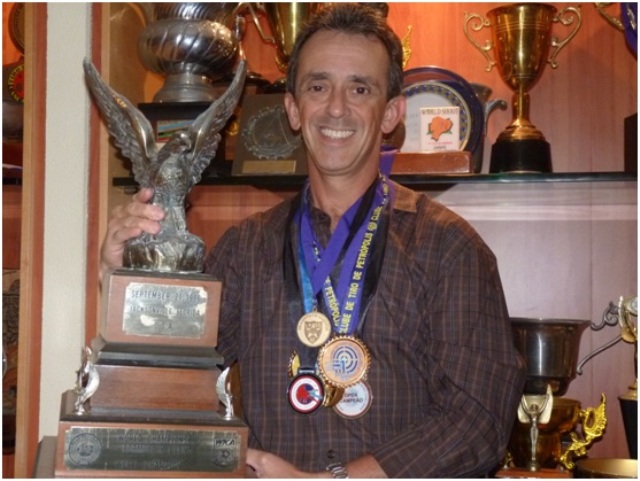
Com o troféu de campeão mundial de kart nas mãos e medalhas do tiro prático no peito, Guga Ribas respira competição. Chego aos 50 anos satisfeito com o que fiz até agora. Mas isso não significa que pretendo parar. Após esta maravilhosa entrevista, agradeço ao Guga de todo o meu coração pela atenção, simpatia e humildade dispensadas. E tenho uma novidade pra vocês: junto com o primo dele, o Ronaldo Marques, convencemos o Guga a participar conosco da etapa de Limeira da Fast 90’s, em conjunto com a recém criada AKHB (Associação de Karts Históricos do Brasil), no dia 29 de março. Isso mesmo: estamos trazendo um campeão mundial de volta às pistas, ainda que seja em uma prova de caráter amistoso! Um grande abraço pra vocês e até o mês que vem! Rodrigo Bernardes English Version:  How’s it going, guys? How’s it going, guys?
When I decided to write about the biggest names in the history of national karting, or the “Marvados”, as we affectionately refer to them here, I obviously thought immediately about our karting World Champions: Guga Ribas, Gastão Fraguas and Rubinho Carrapatoso. My intention was to write a piece about all three and so I sent them a questionnaire, to help me write about parts of their careers that are still unknown to the public. As it goes, Guga’s interview was simply sensational! I am delighted to be able to reproduce the whole text here for you all. For you all, Guga Ribas: NdG – Espaço Karting: How did you get started in karting? Guga Ribas: I was always in love with cars, speed and challenges, since I was a small child. If it wasn’t for a lawyer, and a great friend of my father’s, Jose Perez de Rezendeter, inviting my brothers and my father to watch a karting race in the fantastic, but now defunct Maqui-Mundi track, I doubt I’d have ever known about the sport that led me to be here, writing this article. At the time, I was 13 and asked my father if I could go with him. Gosh, I still remember as if it were yesterday; arriving at the track and hearing the roar of the motors going round the bends, the burnt smell of petrol mixed with M50 oil, the speed of those “little cars” rushing past me and how fixated I was with them. I was absolutely fascinated. Little did I know that that first contact with karts and that atmosphere would be the beginning of my career. 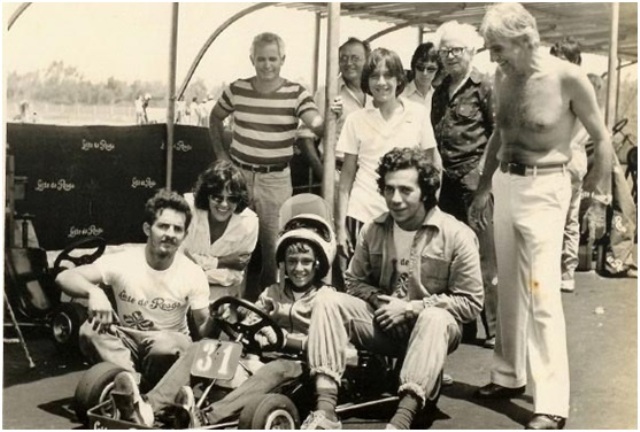
On the way back home I asked my father if he could give me a kart and let me race; a request he quickly answered. As well as always supporting us in everything we wanted to do, my father also loved speed. As a result of this, the whole family ended up involved in karting for almost 20 years. In the middle of that year, the Leite de Rosas (“milk of the roses” in free translation) team was created, with 5 drivers: Jose Rezende, the only one with any experience, my brother Mauro Ribas, my cousin Osvaldo Modesto Leal, my godmother’s husband and a great family friend, Hamilton Borges Fortes and myself. 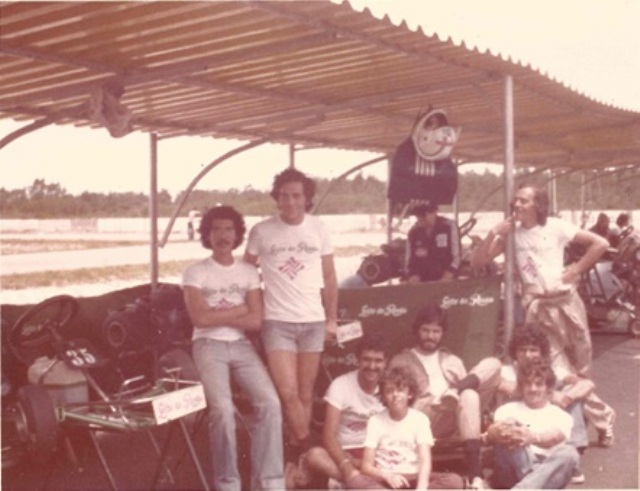
My father wisely said that I would train with the rest of the team but that I would only race in the final stage of that season. I agreed and on November 27th 1977 I participated in my first race and gained my first victory. NdG – Espaço Karting: How would you describe your driving style in the kart? Guga Ribas: It’s impossible to talk about my racing style without talking about how it was formed. As I always say, I don’t have idols, mainly because I believe that idols should be perfect and never make mistakes, which we all know is impossible. On the other hand, I hold a few drivers, athletes and “normal” people as examples, some of whom I followed and some I didn’t. All of them have been and still are a part of my life today. 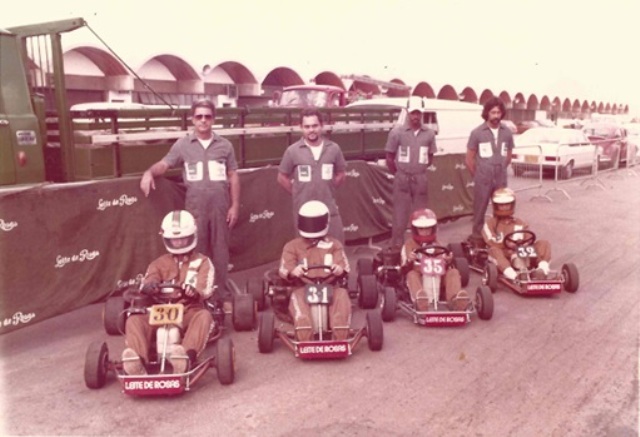
As I’m one of the oldest (racers) of my generation and I began early for the time, I ended up being part of a middle-generation which had examples such as Ayrton Senna, Mario Sergio Carvalho, Dionísio Pastore, Eduardo Vargas, Mario Batalha Seixas (Marrom), Mike Wilson, Alessandro Zanardi, Gianni Morbidelli, with whom I had the pleasure of competing. Also, the generation before that had drivers such as Walter Travaglini, Toninho da Matta, Terry Fullerton, amongst other legends in our sport. I was very lucky to be able to watch them race. Over time I ended up taking a little from each of them and created my own personal style. Each time I watched them, each time I raced with them, each day in the box during the races caused me to learn a lot, I took in a lot of information and afterwards I would study it without realising- changing and adapting myself. It ended up being a processing of maturing. I owe each one a lot, and also others who I will mention later. 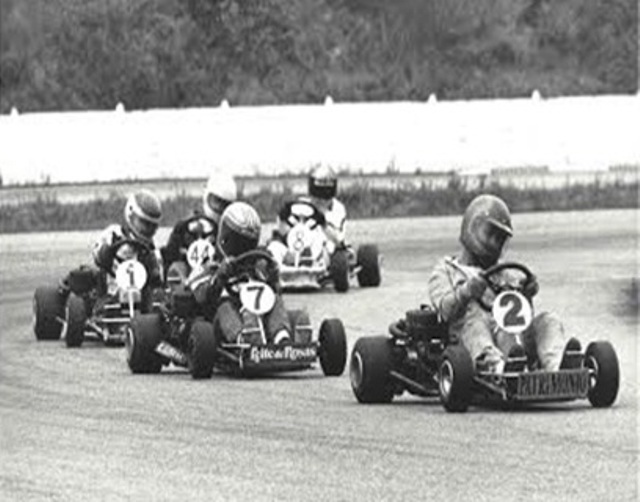
So, my style ended up becoming very aggressive on the track and very technical in the box. NdG – Espaço Karting: Tell us about the World Championship in ’86…do you have any exclusive stories about the championships? Guga Ribas: It was my second world championship and this time I was in a team that was semiofficially mine. I didn’t have a teammate and because of this my mechanic – who was absurdly experienced- could give me 100% of his attention. I was also much more prepared than the World Championship in Parma the year before. I knew that I was capable, but I was aware of how difficult it is to win a world championship. Only those who have competed in one can understand what I mean. 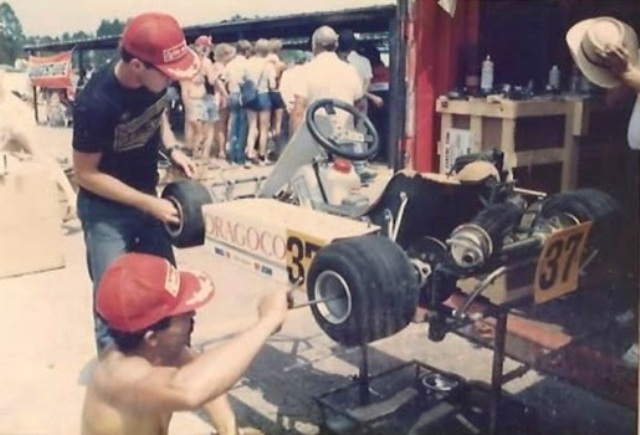
There is some mystery surrounding my title. Some people say that I only won it because the European racers decided to give up. Obviously I can’t guarantee that I would have won if the Europeans had participated, but the fact is I was one of the quickest right from the first training sessions. Everyone trained the whole week and only decided not to compete on the eve of the classification, after a meeting that was called by Mike Wilson with the European drivers. It’s important to stress that during the whole week, we all trained normally and I was always in the top three. So, the fastest were always Gianni Morbidelli, Yvan Muller and myself. Before making the decision not to race, on the night before the classification, I spoke with a few European drivers and also with Mr. Bruno Grana, the owner of my team (IAME) and they all encouraged me to race. In my opinion, the decision for a European boycott was much more political than technical. It really was a dangerous track, but we were all aware of this from the first training session. So, why wait until the last day of training to pull out? Of course their pulling out made things simpler, but at no time was it easy and the Europeans didn’t belittle my victory. Quite the opposite. 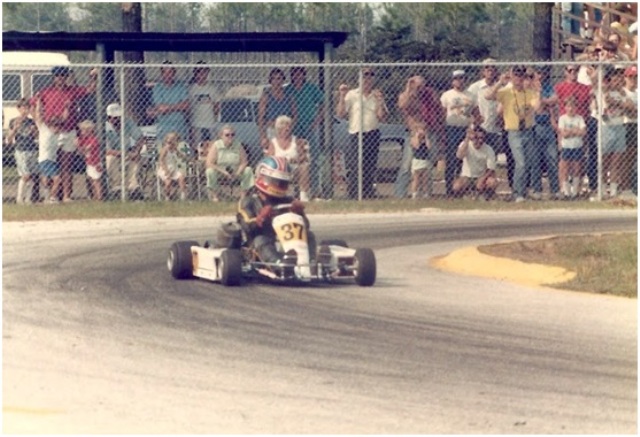
The main racers, like Yvan Muller, Jorn Haas, Lars Forsman and the great majority of the European racers came and congratulated me. American teams invited me to compete in the USA. During the party that IAME threw for me, the delightful Mr Lorenz Aebi, factory owner and creator of the famous IBEA carburettors, presented me with two of his carburettors and spoke to me about going to Europe to race. A few months later, the adorable Mr Bruno Grana, the owner of IAME, came to Brazil and invited me to race for the factory in Europe the following year. I didn’t accept his invitation because I understood that my career in karting would finish there. As it did. I wanted to move on to open wheel race cars. NdG – Espaço Karting: Who were you main adversaries in karting? And which racers impressed you most? Guga Ribas: I had many exceptional adversaries. In Brazil, the list is a long one: Eduardo Vargas, Mario Batalha Seixas (Marrom), Tullio Meneghini, Paulo Carcasci, Oswaldo Negri, Mario Sergio Carvalho, Bruno Aguiar, Ricardo Matos, among others. In the world championships in which I competed, the drivers who impressed me most were: Mike Wilson for being the best driver I’ve seen for making the most of opportunities during a race and Gianni Morbidelli for his aggressiveness at the wheel. NdG – Espaço Karting: I read an interview from around the time of your world championship victory in which you said that you didn’t want to go after the biggest categories in auto racing, but simply to follow the family business. Is that true? Guga Ribas: I was very young and full of dreams. I didn’t really know what I wanted to do. At the time, the world was much “bigger” than it is today. Means of communication were much more precarious, everything was more difficult and I was always very family-orientated. Having to live alone and face challenges in a strange country was too much for me at that time. I always needed my friends and family. That much hasn’t changed until now and will never change. My family and my friends are the most important things I have in my life. I don’t regret my decision not to leave. My career here in Brazil has been long and I’d like to say, victorious. I’m happy with the way it turned out. NdG – Espaço Karting: What was your partnership with Rino Genovese like? Guga Ribas: Do you mean “Véio”? My second dad! A guy who took me as a son, friend and partner. Best man at my wedding. He was the one he would give me cigarettes when we both smoked and my dad wouldn’t let me smoke yet. I wasn’t just a race car driver to him. He taught me much more than about races, victories, failures, improvements, engines and carburettors. He was always the King of carburettors. Every race, I had to test the various different carburettors that he would always bring. However, what really brought us together was that we had an unbreakable bound. He helped me become the man I am today with our late-night chats about family, business, character, about life, really. The only way to describe my relationship with Rino is to say we were like father and son. Of course, we had our disagreements....many of them! But always with a lot of respect and immeasurable mutual admiration. 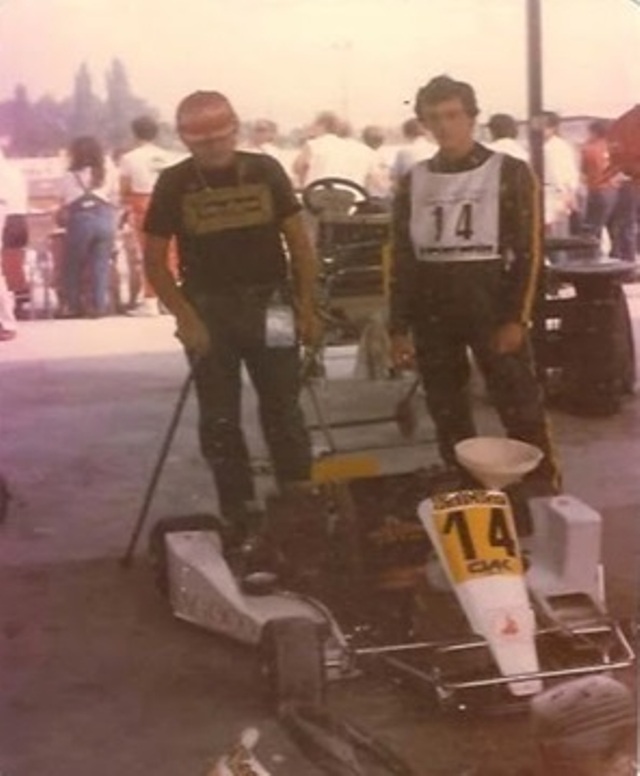
My only regret was not having him by my side when I won the world championship. I couldn’t afford for him to come with me. I know that this hurt him enormously, but he was never able to tell me. As a great friend and father, he was full of pride for OUR victory. Mainly for being a victory with an engine he made, by a driver he prepared. To give you an example, in the ’85 World Championship in Parma, in the first eliminatory round, I – who had always had an extremely aggressive trait, especially in the turns- lost a few positions. Afterwards, he came to me, told me off and asked why I had done so badly in the turns. I didn’t understand and answered: “but I passed the guy who was going round in front of me”. He then took my by the arm and made me watch the turns in another eliminatory round and told me to “watch closely how they turn”. It was only then that I realised that the only positions represented were the first three or four rows and from then on, the winner was whoever got there first. In the other turns I went back to winning lots of positions and he told me “my driver’s back!” After the loss of my parents, he was certainly the greatest loss in my life. NdG – Espaço Karting: Tell us about the adventure of opening a karting chassis factory here in Brazil in the ‘80’s: the main difficulties, the victories… Guga Ribas: In the beginning, it was a very turbulent process. To tell the truth, this project was my father’s idea. He was always extremely entrepreneurial. However, at that moment in my career I didn’t want to be a businessman, but a race car driver. I argued with him a lot and told him that if he wanted to do it, I wouldn’t be part of the project. That was how it was for the first 6 months. 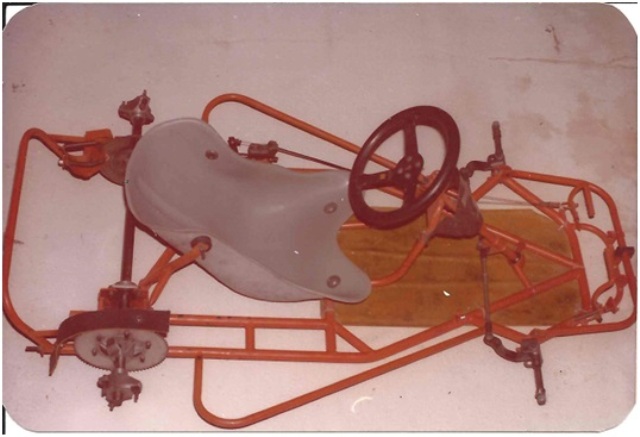
In the beginning of 1983, my father bought a project from Chiquinho Lameirao and started developing it with one of their employees and with his friend as manager. I continued racing with the Mini chassis. In the middle of the year, we started talking about the idea again and set everything straight. From then on, I started managing the development project and we started doing some tests on the track. In 1984, I debuted the CLR chassis with an innovative project for Brazil: a triangular chassis with a mechanical brake. That season, I was in all the pole positions, except one because I had a problem in the classification. I led all of the races and won only two. In all the others I had mechanical problems. Throughout the year, the project went through a series of adjustments and I was able to win almost all of the matches I took part in. In the Brazilian Championship in Ipatinga, of the five categories I took pole position in three. The project was much more successful, but we didn’t have the infrastructure to take on Mini, which was already the largest factory in Latin American and fought hard to keep its competitors at bay. Each time we managed to get a good driver to race with our equipment, they [Mini] offered something better and we weren’t able to compete. 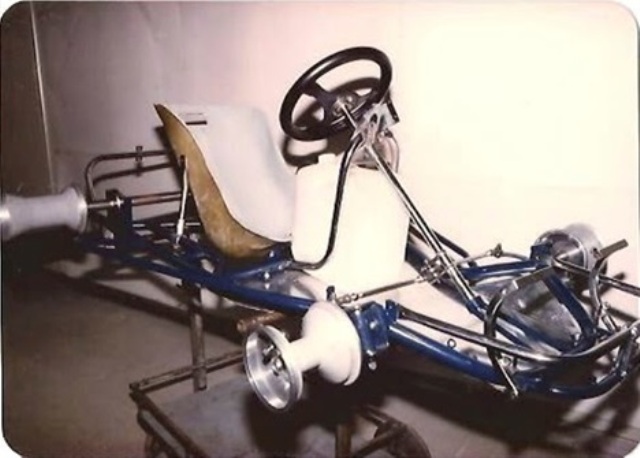
By the time I stopped go-kart racing in 1986, the CLR project had lost force and we slowly left the market. But it’s much more gratifying to have participated, managed and developed a project that ended up generating the best karting chassis in Brazil for a few years. I’m proud of that. NdG – Espaço Karting: What made you go into a career in sport shooting? Tell us about this other challenge and also tell us a bit about your achievements in this area. Guga Ribas: In 1994 I did my final season in the Brazilian Championship of Brands and Drivers. I was already getting tired of frequent trips and the routine of racing. I had also had my first two children and, as I said, I was always very aggressive on the track. One day during training here in Rio I suddenly found myself thinking, during a turn, what would happen to my children if I had a serious accident. I knew that, with my driving style, the chances of an accident were higher. From then on, I started to change my style to be less aggressive. It like a self-punishment so I decided to stop. 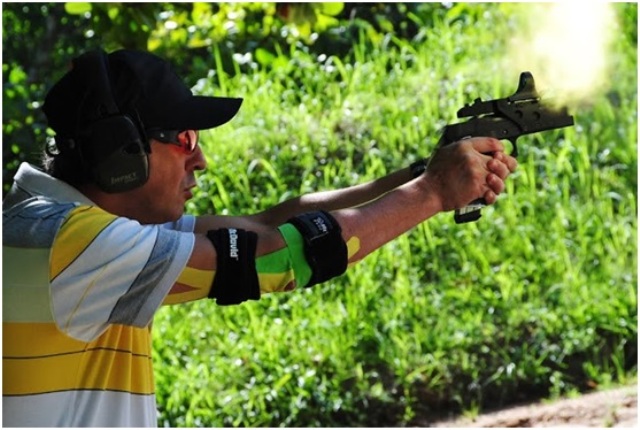
I stayed that way for a year but at the end of 1995 I received an invitation to race in the Stock Car championship. I talked it over with my wife (and eternal partner) and decided to return [to racing]. It would be a totally new experience because it would be the first time with a team that wasn’t my own. Until then, I had always been the owner and leader of my teams. It wasn’t the best experience I’ve ever had in auto-car racing and I decided to stop definitively in 1996. But the problem is that I’m in love with competition. I’ve lived in them since I was 13 years old and I think I’ll die competing. So, what could I do from then on? I thought about Practical Shooting, which was already my hobby and I had already participated in some regional, national and even international competitions, but without training. 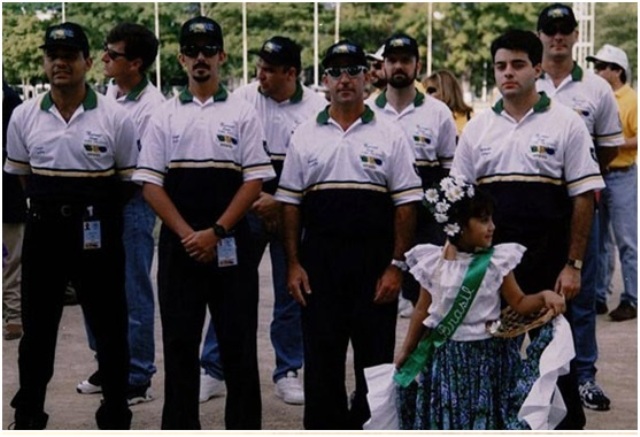
I started training seriously and gave myself a goal in 1997: to classify for the Brazilian team and participate in the Latin American Championship in Venezuela at the end of that year. To do so I needed to be in the top 4 in the ranking at the time of the competition. I didn’t manage it. At the time of the allocation, I was in 5th place but luckily for me, the leader of the ranking allowed me to enter the Brazilian team and I was drafted in. We were the Latin American Champions as a team and I had the best individual result of the team. Since then I’ve been part of the Brazilian teams in all the international competitions. Interestingly, however strange it may seem, there are similarities between the two sports. Practical Shooting is a highly dynamic sport that demands quick-thinking, excellent physical conditioning and extreme concentration. The competition is made up of different scenes and the results of each one are totalled, thus the winner has the most points in the least time. Exactly as if it were several circuits in the go-kart or auto-car. As each scene in the shooting competitions doesn’t last more than 30 seconds, the similarity with a turn is impressive. When you are waiting for the official to sound the horn to start the competitions, your heart rate increases, you need total concentration and the physical explosion, controlled by your thought-process, has to be perfect. Just like a turn around a race track. In other words, practical shooting, for me is like a race with several turns. It’s very interesting. 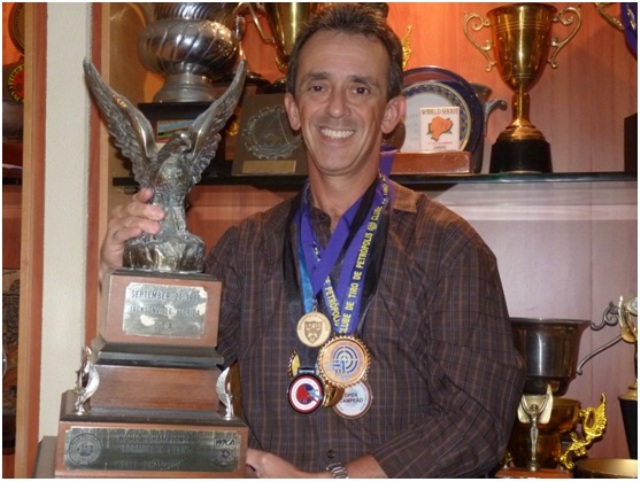
I’ve been doing this sport for 17 years and throughout this time I’ve ended up making a name for myself nationally and internationally. I’ve won the Pan-American Championship 4, I was the vice world champion twice, I won a European championship, other times I’ve been vice-champion in European championships and I’ve won several Brazilian and state championships. I turned 50 satisfied with what I’ve done until now. But that doesn’t mean I intend to stop. After this incredible interview, I thank Guga with all my heart for his attention, kindness and humbleness. And I have some news for you all: we have convinced Guga, together with his cousin Ronaldo Marques, to participate in the Limeira stage of the Fast 90’s competition, in conjunction with the recently created AKHB (Historical Karting Association in Brazil) on March 29th. That’s right- we’re bringing a world champion back to the race track, even though it’s just a friendly race!
| 
